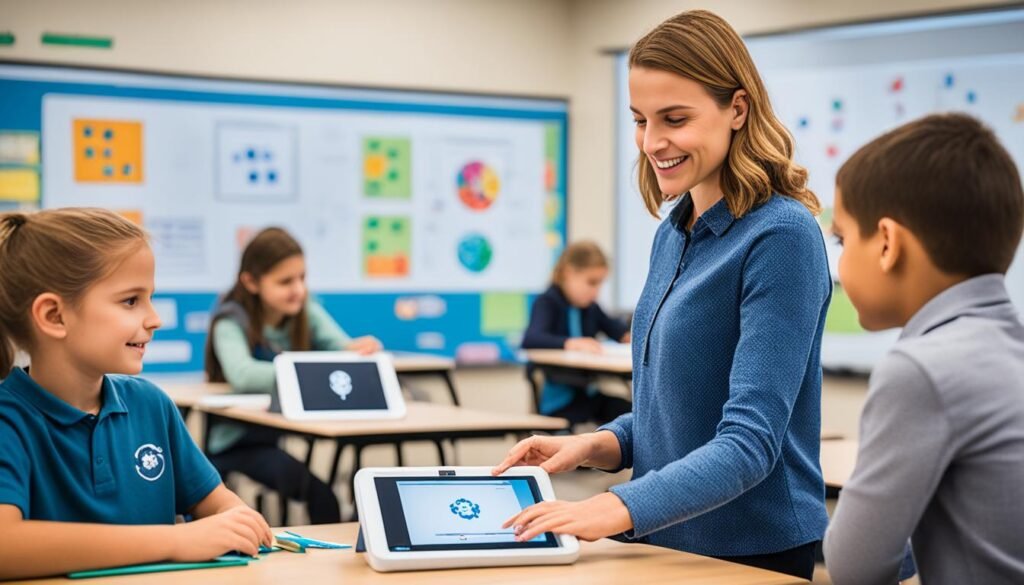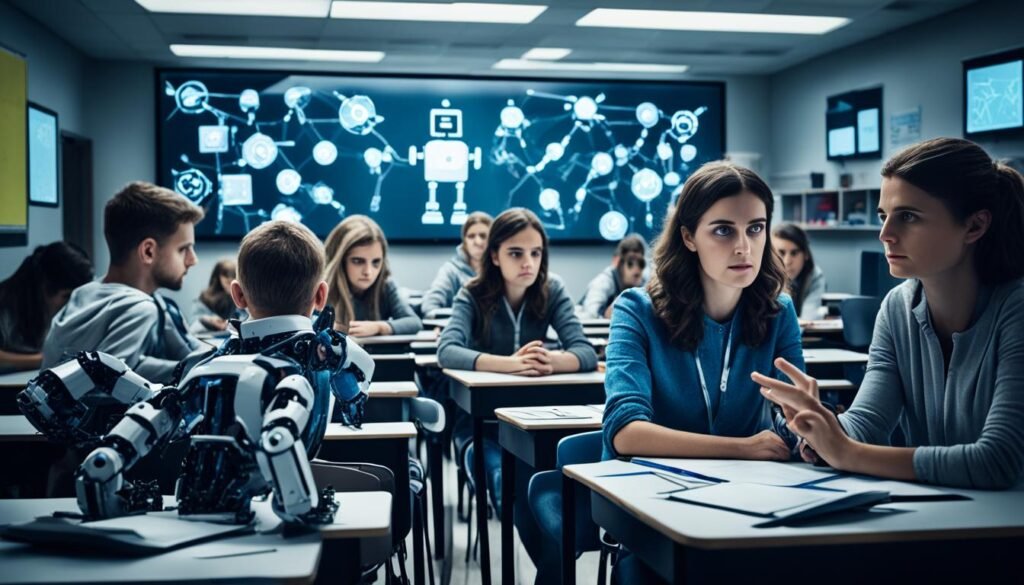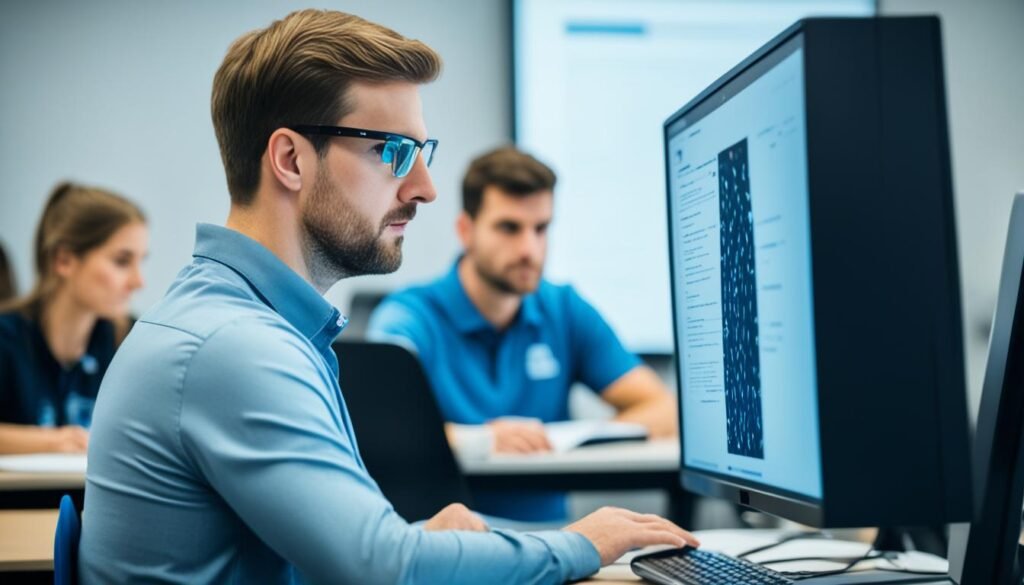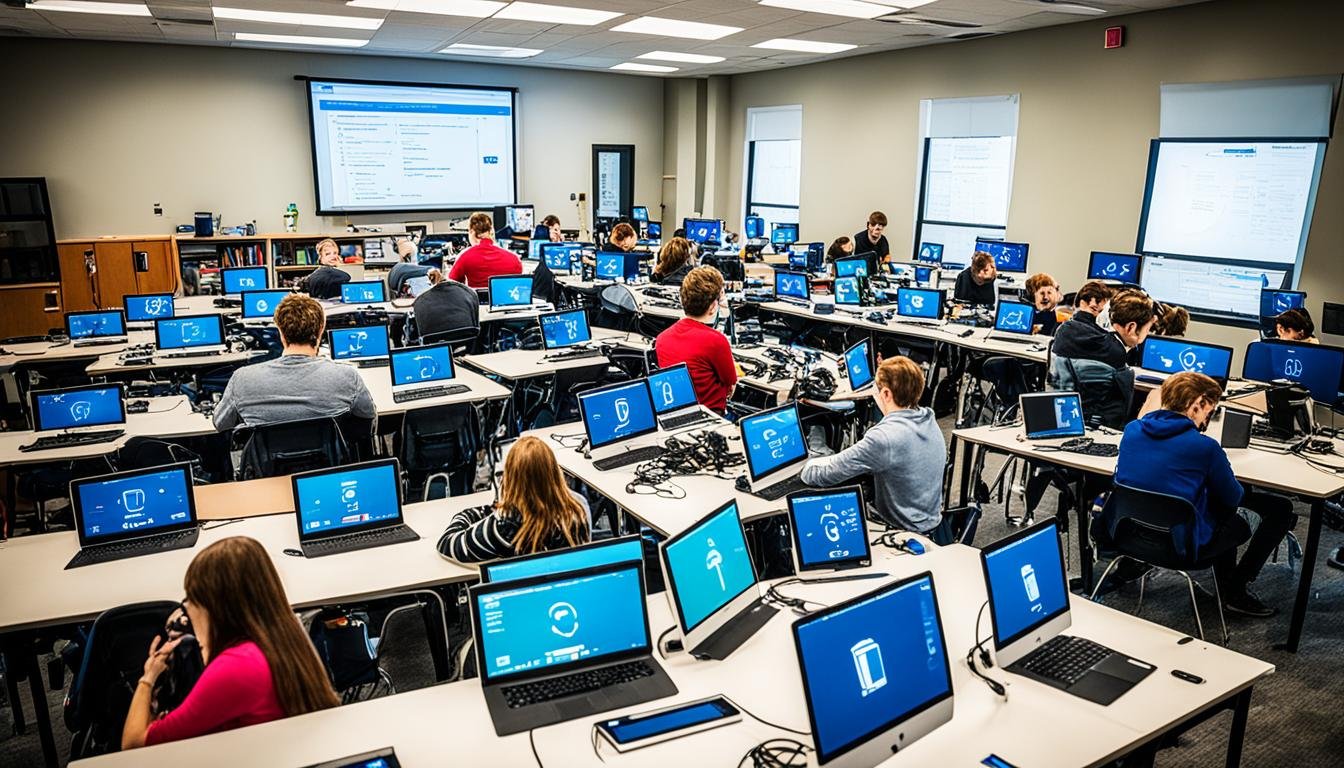AI is becoming a big part of education, but it also brings big concerns. Over 30% of students might cheat with AI tools. Yet, 60% of teachers think AI helps, and 70% believe it can make lesson planning easier. But, 55% worry that AI could replace their jobs.
As AI becomes more common in schools, we need to look at the downsides. These include issues with learning, privacy, and how students grow. It’s important to understand these challenges.
Key Takeaways
- AI tools can facilitate academic dishonesty, with 30% of students likely to cheat using AI
- Overreliance on AI may lead to neglecting traditional teaching methods and critical thinking
- AI-powered software often adopts a one-size-fits-all approach, potentially failing to address individual needs
- Lack of human interaction is a significant drawback of AI in education, as positive student-teacher relationships are crucial for success
- Implementing AI in education can be costly for teachers and institutions, creating accessibility challenges
What is Artificial Intelligence in Education?
Artificial intelligence (AI) is a cutting-edge field that aims to make machines do tasks that usually need human smarts. This includes things like solving problems, learning, understanding language, and making decisions. AI in schools tries to mimic how humans think, learn, and adapt to new info to make learning better.
Definition and Brief History of AI in Education
AI in education has a long history, moving forward with better computer power, cloud tech, and big data. Tools like Grammarly and search engines Google and Bing use AI. Khan Academy even launched an AI app called Khanmigo for one-on-one tutoring and homework help. The U.S. Department of Education is now using AI to help students learn better for their future careers, as President Biden mentioned in a recent order.
But, AI’s fast growth has led to worries about data privacy and rights to ideas. Parents, teachers, and students are concerned about AI’s ethics in schools. It’s important to make clear rules for using AI to protect students and keep learning honest.

“Software used to forecast the risk of reoffending incorrectly marks Black defendants as future criminals at twice the rate of white defendants.”
There’s a big worry that AI could make mistakes and keep biases. We need strong rules and guidelines for AI in schools. This way, all students can have the same chances to succeed, no matter who they are or where they come from.
The Potential Risks of Bias and Errors in AI
AI is becoming more common in education, and we need to know the risks it brings. AI models, like ChatGPT, learn from huge amounts of data. This data can have biases and mistakes, leading to ai bias in education, ai errors in learning, and ai misinformation in classrooms.
AI in education can be biased. The data it learns from may reflect social inequalities. This means AI might make unfair decisions or suggest things that could harm certain students, like those who speak English as a second language or belong to minority groups.
- Stanford University found that AI bias can negatively affect non-native English speakers, leading to accusations of cheating.
- Dartmouth researchers discovered biases and stereotypes baked into language models, resulting in assumptions about occupations based on gender.
- Diversifying the creators of AI can directly impact the data produced by algorithms, reducing biases.
AI can also spread ai misinformation in classrooms if its training data has errors or outdated information. This can give students wrong facts or mislead them, hurting their learning.
“AI bias refers to algorithms that can produce biased results reflecting and perpetuating human biases within society, including historical and current social inequality.” – IBM
We must tackle these risks to make sure AI in education is fair and responsible. Teachers and developers should know about AI’s biases and errors. They should work to lessen their effect on students’ learning and results.

By facing these challenges and acting on them, we can use AI’s benefits while reducing its downsides. This way, all students can have a fair and inclusive learning experience.
why ai is bad for education
AI often takes on the biases in the data it’s trained on. This means AI tools in schools can spread harmful stereotypes and social inequalities. For example, biased algorithms might lead to unfair grades or recommendations.
About 30% of college students have used ChatGPT, an AI language model, to write essays. This raises worries about cheating and losing the skill of writing.
AI can also give out wrong information because of bad data. Students and teachers shouldn’t trust AI as the full truth. A recent survey found 4 in 10 students might use AI to do their homework, which could hurt their thinking skills.
Concerns About AI Perpetuating Biases and Misinformation
Most leaders in the edtech industry are white, male, and middle-aged, says the Consortium of School Networking’s 2023 report. This lack of diversity worries people about AI’s potential to keep biases and marginalize certain groups.
AI has been shown to create biased and harmful content. This includes racism, sexism, and ableism. Using such AI in schools could make these biases worse and harm students’ learning.
| Concern | Impact |
|---|---|
| AI perpetuating biases in schools | Unfair grading, recommendations, and marginalization of underrepresented groups |
| AI spreading misinformation in classrooms | Students and teachers accepting inaccurate or biased information as fact |
| AI-assisted cheating and plagiarism | Erosion of essential writing and critical thinking skills |
Educators and policymakers need to think hard about using AI in schools. They should make sure it makes learning better for all students, not worse.

AI and the Challenge of Academic Integrity
AI has made big strides in education, bringing both good and bad changes. One big issue is the rise of AI cheating and plagiarism. This threatens the honesty of academic work.
Students now use AI tools like ChatGPT to write essays, answer questions, or finish homework. This has led to more ai cheating in education and ai plagiarism in classrooms. Students try to pass off AI’s work as their own. On the other hand, AI tools are made to spot ai-assisted academic dishonesty, helping teachers catch cheating students.
But, these AI tools are not perfect and can sometimes wrongly accuse students of plagiarism. It’s easy for students to use AI to do their work, making it hard to truly measure their learning. This also challenges the integrity of academic work.
“The rise of AI-assisted cheating and plagiarism poses a significant threat to academic integrity, as students can easily leverage powerful language models to generate work that they can pass off as their own.”
Universities and teachers face a tough challenge. They need to use AI wisely while making sure students learn to think and solve problems on their own. This means setting clear rules, teaching students and teachers about AI use, and having strong policies.

The Potential for AI to Isolate Students
As we bring AI into education, we must watch out for its downsides. One big worry is how AI might make students feel cut off from other people. If students spend too much time with AI tools and not enough with teachers, they might feel left out and lose interest.
This could really hurt how motivated and involved students are, which might even lead to more dropouts. Even though we live in a digital age, we still need to talk and work together with people. AI can help with tasks, but it can’t match the way we read each other’s feelings and emotions.
Without talking and being with others, students might find it hard to get along in school and later in their careers. We need to make sure AI doesn’t take away from the important human connections in school. This helps students grow and do well in all areas of life.
“The more we use AI in school, the more we might lose the human touch that students need to grow and be happy.”
As AI changes education, we must focus on keeping students engaged and building strong relationships. We need to keep the human touch in learning. By finding the right balance, we can use AI’s benefits without losing the connections and skills students need for the future.
AI and the Future of Teaching Roles
As AI gets better, some teachers worry about its effect on their jobs. AI can change education, but the bond between teachers and students is key. Studies show that a good relationship between teachers and students helps students do well in school.
AI might make some teaching tasks easier, which could mean teachers work less. But, teachers are still needed to guide, inspire, and help students learn. They offer something AI can’t: a personal touch, empathy, and skills like creativity and critical thinking.
Addressing Fears of AI Replacing Human Educators
AI will definitely change education, but teachers worry about losing their jobs. A recent survey found that half of teachers think AI will have a bad effect on teaching and learning in five years. Only 27% see it as positive.
Teachers know AI can help improve education but also worry about its misuse. It could lead to more plagiarism. AI might also make students less motivated, as they question their future and the worth of their skills.
To ease these worries, schools must train teachers on using AI right. This way, teachers can use AI to improve education without losing what’s important: critical thinking, creativity, and real connections with students.
We can use AI and human teachers together to make education better. This way, we keep the best parts of teaching while using technology to help.
Balancing AI’s Potential with Its Drawbacks
AI is changing education in big ways, but it also brings challenges. Educators and policymakers must find a balance. They need to use AI’s benefits without relying too much on it.
AI can help teachers, speed up learning, and make education more personal. It can adjust content for each student, give quick feedback, and spot potential problems. AI also makes hard subjects easier to understand with virtual reality and simulations.
But, there are risks like bias, fake information, cheating, and replacing teachers. AI might keep old biases, making learning unfair. Also, AI can help students cheat, which goes against the true spirit of education.
Too much AI can make students feel isolated, cutting down on important human interaction. It’s key to keep a balance. This way, teachers can still be the guides and mentors they should be.
To use AI well, schools must focus on keeping data safe and checking AI’s quality. Teachers need training to use AI in a way that helps students the most.
By finding the right balance, educators can make AI a powerful tool. This balance keeps the core of education safe while using AI’s benefits. This approach will shape the future of learning and keep teachers at the heart of education.
“The integration of AI in education must be carefully considered, balancing its potential benefits with the need to preserve the human touch and maintain academic integrity.”
Strategies for Responsible AI Integration in Classrooms
As AI becomes more common in schools, teachers must use it wisely. They should see AI as a tool to help, not replace, human teaching. This way, teachers and AI can work together to make learning better.
Teachers should set rules for AI use in class. They should stop students from using it for tasks that show off their own skills. This keeps education focused on what’s important: learning from humans.
Guidelines for Teachers to Leverage AI While Preserving Educational Values
- Use AI as a collaborative assistant, not a replacement for human teaching. Leverage the AI’s capabilities to assist in instruction, assessment, and real-time feedback, while teachers offer guidance, interpretation, and deeper engagement with the material.
- Establish clear guidelines and boundaries for the use of AI in the classroom. Prohibit students from using AI for tasks that should demonstrate their own learning and critical thinking.
- Educate students about the potential biases and limitations of AI tools, encouraging them to think critically and request source links for any AI-generated content.
- Incorporate AI literacy into the curriculum, teaching students how to evaluate the reliability and accuracy of AI-powered resources.
- Stay up-to-date with the latest developments and best practices in the responsible integration of AI in education, and provide professional development opportunities for teachers.
By following these strategies, teachers can use AI to improve education without losing what makes it special. This ensures AI is used responsibly in the classroom.
“The key to successful AI integration in education is to find the right balance between technology and the human touch, where AI enhances learning without replacing the vital role of teachers.”
Conclusion
Artificial Intelligence (AI) in education brings both good and bad sides. AI tools help teachers, speed up learning, and make education more personal. But, we must watch out for bias, wrong info, cheating, and feeling left out among students. Teachers are key in making the most of AI while keeping education’s human touch.
Teachers can use AI wisely to improve learning without losing the personal touch. This balance is key. We need to make sure AI in schools is used right, focusing on bias, privacy, and not replacing teachers.
As education changes, we must work together. Educators, policymakers, and tech experts need to create AI tools that add to, not take away, the importance of human interaction and feedback. This way, AI can change education for the better, making learning and teaching more effective.
FAQ
What is Artificial Intelligence (AI) in education?
AI in education uses computer systems to do tasks that need human smarts, like solving problems and learning. It helps with personalized learning, checking student work, and sharing information.
How can AI perpetuate biases and spread misinformation in the classroom?
AI learns from data that might have biases or mistakes. So, it can keep those biases and treat some unfairly. Also, AI might share old or wrong info, making it seem true to students.
How can AI-assisted cheating and plagiarism impact academic integrity?
Students easily use AI tools like ChatGPT for cheating and plagiarism. This makes it hard to know if students really learned the material. It’s a big problem for keeping education honest.
How can the use of AI in education lead to student isolation and disengagement?
Students spending too much time with AI might feel left out and alone. This can make them less interested and motivated. They might even stop going to school. We still need human contact for students to grow.
How can AI impact the role of teachers in the classroom?
AI might do more of the educational work, but teachers are still key. They teach, inspire, and help students learn. Teachers bring empathy, social skills, and help students think creatively, which AI can’t do.
How can teachers responsibly integrate AI in the classroom?
Teachers can use AI wisely by seeing it as a helper, not a replacement. AI can aid in teaching, checking work, and giving feedback. Teachers should guide, interpret, and engage with students. They should also set rules against using AI for tasks that show off students’ own learning.
